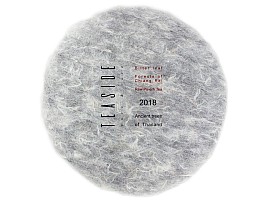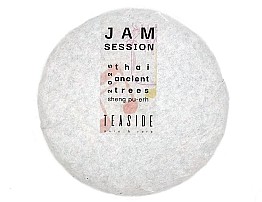2014 “Fox” Raw Pu-erh Tea Cake
Harvest: Spring 2014
Elevation: 1200 m
Trees' age: 300-500 y.o.
Availability: In Stock
This raw pu-erh is made from leaves harvested from the wild mountain forest with many old tea trees, aged at least 300 years and more. They can be 500 or even 700 years old.
The taste of this green pu-erh differs greatly from the taste of all the other Thai pu-erhs presented in our web-store. So we can say, the cultivar of these trees is unique for Thailand. This puer was made in a small family tea manufacture, that can hardly be called a factory or plant. Very nice people, which is very important for us because we believe such things always affect the quality.
The material is from spring 2014 harvest. Fried by hands only in a wood-fired oven (wok). The cake is manually pressed by stone.
Dry tea aroma: milk candy, sweet red apples, pears, tropical fruits.
Taste: milk caramel moves to the background. In the foreground appears fresh pears, plums, sweet mellow notes with some species. Infusion smells with the same dry milk candies and pear caramels which are also in the foreground taste. Some strawberry gum is also in flavor. In the background are wood tartness and pungency of a freshly cut branch, tree sap.
Aftertaste is powerful and long-lasting, with the same basic notes. We've been pleasantly surprised that the aroma passes into the taste so perfectly in a pretty young tea. It will be interesting to store and observe its aging.
State after drinking: clarity, attentiveness, awakeness.
*The cover was designed by artist Irina Verner
2021 Update: Now, six full years later, milk has almost disappeared, giving way to aromatic kinds of wood and ripe stone fruits tending to dried fruits. Ripe red plum, dates, and dried apricots sound distinct. That is, the classic notes of semi-aged sheng from old trees are manifested.
Our Fox is cunning, feminine, and wild even though she lives close to people. In her paws, she carries a “miracle” through the forest. And the entire forest nature is watching her.
Reviews (12)
Today I'm reacquainting myself with the 2014 Sheng Puerh from Thailand. The first time I drank this tea was at the end of '15 and now it's hard for me to remember what it was like then, but now this tea deserves a separate place in my sheng puerh collection. It drinks like expensive alcohol. The body of the tea is like a liqueur with noble tartness, which returns with a dozen shades of dried fruits, tree bark and orange juice. By the way, the infusion is just as similar to juice in color.
Thank you to the TEASIDE project for this opportunity.
- This is a second review, to find out how different the tea tastes now that it is a decade old -
Brief (5-10 seconds) steeps in 90 Celsius water.
Liquor is an almost-clear amber-like in color.
Taste is somewhat fruity with a slight bitter touch, and a short sweet aftertaste that comes with a floral note.
Mouthfeel is light and gives no astringency.
Wet leaves are dark olive green in hue, giving off a soft sweet aroma of a ripen stone-fruit.
I can't detect the apple note that I smelled back in 2021.
Flavor intensity starts to mellow down by the 5th infusion, thus best to steep longer from here onwards.
A longer (1 minute) steep in the next infusion gives a deeper hue to the amber liquor.
There is also a mild astringency that starts to emerge without an increase in the bitter note.
To me the taste difference between 2021 review and now is that the sweet-fruity note is less pronounced and thus the slight bitterness felt on the palate seems to have more presence.
This sheng surprisingly less green in taste than some of the 2010 and 2013 sheng I've tried here.
The liquor gives a pleasant sweet after taste with a candy-like fruity aroma.
Easier to detect when nose to wet leaves, which I smelled red apples as well.
It has a consistent medium mouth-feel with just a slightest of astringency after many consecutive brews.
Bouquet: strong woodsy with a slightly roasted chocolatey pickled cherry note to it followed by huge ripe fruity layer of dried and fresh figs, raisins and dried plums. Within its woodsy section there you'll discover Asians most finest furniture art from cherry wood, to hints of elm wood & cypress. But there is also something nuttiness to it like sunflower seeds.
Liquor: Different than the usual Yunnan experience this buddy as many of its origins share a more purple variety taste to its profile than the usual fresh raw taste - at least the once I tried so far. But within this range they reach a level of absolute perfection and pureness. You can literally taste this jungle wild environment with all its natural diversity. Within the taste you find everything named as within the steaming atmosphere starting with its slightly roasted Asian wood furniture base followed by rich dark chocolate paired with subtle undertones of licorice, pickled cherries and dried plums, figs and raisins plus hints of sunflower seeds. Within the aftertaste a long very ripe fruity echo (or windfalls) keeps comforting your tasting buds for quite a long time even the last sip is long done - like fermenting fruits especially pears with a lot of their skin but also red apple sking parts mixed underneath it. If you let it cool down and take a sip there is a good vibe of watermelon to it especially including the taste of its stones.
In the aroma of a dry leaf - peach, flowers, a little menthol. The aroma is exotic, I have not seen anything like this in Chinese shengs.
On the first steeps a magical, complex aroma with a dominant peach fruitiness. After the 3rd infusion, unfortunately, we have to say goodbye to this aroma, it turns into a more boring grated juicy green leaf, hazelnut, which lasts exactly until the end of the tea party.
The taste on the first steeps is slightly bitter, astringency. I would not call this sheng very soft, but it is not greenish bitter either. Further - a distinct sourness in taste and aftertaste, medium strength, pleasant astringency.
According to the body state - in the description, everything is correct, the state is pure, without any special bodily sensations, it is able to make a sleepy person vigorous and sensible.


















